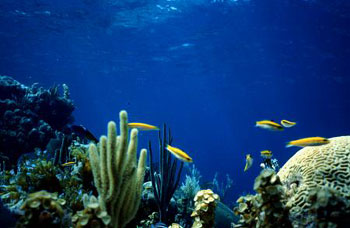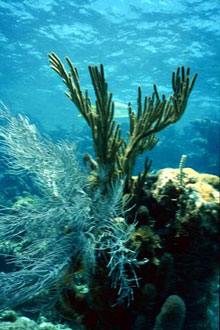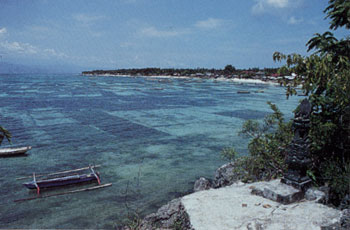Coral Reefs on the Brink
Air Date: Week of June 4, 2004
PART 1: The diversity and beauty of coral reefs have forever fascinated and enchanted us. Writer Osha Gray Davidson has explored reefs around the world and written a book called “The Enchanted Braid: Coming to Terms with Nature on the Coral Reef.” He talked with Living on Earth’s Steve Curwood about how much reefs have changed in the last decades and why he thinks they’re worth saving.
PART 2: Scientists at the University of Queensland in Australia say that warming temperatures could cause the demise of Australia’s Great Barrier Reef within the next 90 years. Ove Hoegh-Guldberg, the paper’s lead author, talked to host Steve Curwood about his most recent research, and his call for a cut in global emissions to save, what he thinks, is one of the world’s treasures.
Transcript
CURWOOD: From the Jennifer and Ted Stanley Studios in Somerville, Massachusetts, this is Living on Earth. I’m Steve Curwood.
More than 30 years ago I went diving in the Virgin Islands into the wonderland known as coral reefs. But when I went back a few years ago, all had changed. There were still a few bright rainbows of fish and coral, but most of the area was ragged and bleak. It’s not just a problem in the Virgin Islands; pollution and exploitation have taken a heavy toll on coral reefs around the world, and climate change is threatening to make matters even worse. Indeed, according to a group of scientists in Australia, warming temperatures could cause the demise of the world’s largest coral formation: the Great Barrier Reef. We begin our program today with Osha Gray Davidson, author of “The Enchanted Braid: Coming to Terms with Nature on the Coral Reef.” His book chronicles the natural history of what he calls “the soul of the sea.” Osha, can you explain what you mean by that?
DAVIDSON: You have to understand about coral reefs that they only make up about two-tenths of one percent of the area of the global ocean, and yet one-third of all marine fish species are found there. And their estimated number of species of all kinds living there is somewhere between one and nine million.
So coral reefs are just this unbelievable tiny fraction of the sea, but that so much of the sea depends on. It’s a nursery for all sorts of fish. The small fish live in and around the coral reef, and then when they grow they leave the reef area and they go out into the ocean. And they affect the entire ocean. So by saying that they’re the soul of the sea, what I mean is they’re the very heart of it, and the sea would be a completely different thing if it weren’t for coral reefs.
CURWOOD: There’s a part in your book where you describe a snorkeling expedition that you make. And it has some, well, some wonderful descriptions in it. I’m wondering if you could read that for us now.
DAVIDSON: Sure. (READING) I must have approached the reef crust, for all at once living corals were everywhere in the amazing variety of color and form that I had read described. Leather-like greenish corals. The colony folded in on itself many times. Large tabletops of lacey coral structures, comprising perhaps a million individuals, their tiny tentacles still withdrawn and waiting for darkness. Blue-tipped corals, and others with a reddish tinge. And strewn among the bottom, like upside-down mushrooms, Fungia corals.
Fishes were everywhere too. An orange and white striped clown fish peered out from a tangle of purple-tipped stinging tentacles belonging to a sea anemone. Curiosity got the better of him, and as long as I remained immobile, the clown fish inched his way toward me. As soon as I moved, however, he tore back into the safety of the tentacles, like a base runner tagging up. A black-tipped reef shark swam lazily by. After moving out of range, the shark returned, eyed me for a moment, and then disappeared again.
Multicolored grasses poked in and out of holes. Angel fishes of many varieties nibbled bits of algae from rocks and coral. Large gaudily colored parrotfishes did more than nibble at the coral. They bit off entire chunks of coral, hard skeleton and all. One coral scientist has described the parrotfish’s unique ability this way: they’d eat a McDonald’s parking lot to get the grease out of it.
|
|
DAVIDSON: You’re absolutely right. Reefs have declined dramatically. I mean, when I was in Florida in the very early ‘70s, comparing that to what I found when I started research for this book – and I spent a few weeks at the Mote Marine Laboratories in the Florida Keys – and it was amazing the difference. The large stands of elk horn coral were gone. And that was because of a disease that had gone through. And that’s something that hasn’t gotten all that much attention, the role of disease. It’s not just coral bleaching, which is bad enough. But what we’re doing by putting nutrients into the water, by putting sediments into the water, and by raising the water temperature is we’re turning the coastlines into giant Petri dishes that allow pathogens to grow and destroy all sorts of marine life. So there was a massive die-off in the Caribbean of elk horn corals, and they’re no longer the dominant coral on many reefs. And that’s just in the blink of an eye that that’s changed. CURWOOD: Help me a little bit please with the biology of coral. You look at a coral reef and it looks like plants, and yet these are animals. DAVIDSON: It’s truly amazing – it’s one of the most amazing things about corals. And it’s one of the reasons I titled the book “The Enchanted Braid.” Coral is an animal, it’s classified as an animal, but it’s really a braid of the three primary groupings that the world was organized into in the 18th century when taxonomy was really invented, and that’s animal, mineral and vegetable. Well they’re certainly animals because they don’t photosynthesize. Corals cannot produce their own food, so they have these little stinging darts that come out and they feed on things that drift by. But they only get a small amount of their nutrients from eating these other creatures, and for a long time ecologists had no idea where they were getting their energy. And they looked all around the corals in trying to see what was around them, which is natural enough to do, but they couldn’t account for a lot of the energy that the corals had.
And then the final part of this braid is that corals build reefs by removing calcium from sea water. And they secrete it in these thin layers of calcium carbonate, which is a form of limestone, and that builds the reef. And so you’ve got animal, vegetable and mineral all combined in one single entity. CURWOOD: What are some of the most spectacular coral reefs out there? DAVIDSON: I was off the coast of northern Sulawesi in Indonesia, and as I went down, first at the top, there was coral – just hundreds of species, probably, it was just gorgeous, and multicolored fish -- truly just outlandish and amazing. And then as I went deeper, at about 65 feet, those hard corals – the reef building corals that depend on the light, with their algae in them, to survive – now there are very few of those, and that was beginning to have other species of coral, the soft corals. So that was really the most diverse area, as far as corals go. And once you get down to 100 feet it’s almost all soft corals, these hard to describe but unbelievably beautiful swaying, gelatinous creatures and spiral wire corals. Which if Dr. Suess had invented a coral, that’s what he would have made, the spiral wire. And there were all these sponges, and they’re crinoids, which are these beautiful feathery-headed animals that look like plants. And that’s down at 100 feet. So that was one of my favorite dives -- getting to see, as you go down, the different zones of a reef. CURWOOD: Now, coral reefs are closely intertwined with many local communities and economies. Tell me a story of how local people use the reefs, from anywhere in the world. DAVIDSON: Well, let me go up to Indonesia because that’s one that comes to mind very quickly. When I was there I was on a very small island, and the community was a traditional fishing community. And a man there told me a story through the interpreter. He said that before, years ago, when he would to fish for the day, his wife would start the fire to cook dinner and that was his cue to go out and fish. And by the time she was ready with the water boiling he’d be back with a fish. And he said it now took him two days to get fish for dinner, and that has changed their lives on this island dramatically. It’s had another consequence that boomerangs and ends up hurting the reef again. Because it’s so hard to get fish, they’ve taken in this area -- and many areas of the world -- dynamite fishing or blast fishing. They use – it’s generally, I think, pop bottles filled with gunpowder. And you go out to the coral reef area where there’s a lot of – there are some fish, anyway – you light the fuse and you throw it in the water. It blows up, if you’ve timed it right, so that it stuns a lot of fish and kills a lot of fish, and then you collect them. Well, there are a number of problems there, and one is that you blast a hole in the coral reef itself. It’s enormously destructive. If you just do it once, well, it takes many many years for it to recover. If you just do it once, okay, it will eventually recover. But if you blast fish in one area over and over, what will happen is you’ve reduced the entire area to coral rubble, algae takes over and there’s no hope for it returning. Another effect of this is on the people themselves, the blast fishermen. This is a devastating problem in these areas, and it’s in the Philippines, it’s in Indonesia and many other parts of the developing world. They throw the homemade bombs into the ocean, and when that happens, a certain number of times they misjudge the timing, and it explodes in their hand and they lose hands and arms. And in one village I was told that a quarter of the population of men have lost a limb to blast fishing. So the effects on the people of this desperation, not only does it destroy the reefs, but it destroys the people who are dependent on the reefs.
|

 The clear, clean waters of the Bahamas include many healthy coral reefs such as this site at Sandy Cay Reef, Abaco, Bahamas. (Credit: Craig Quirolo)
The clear, clean waters of the Bahamas include many healthy coral reefs such as this site at Sandy Cay Reef, Abaco, Bahamas. (Credit: Craig Quirolo)  Sunlight is essential to the healthy growth of corals because it enables photosynthetic activities to occur in the zooxanthellae, a symbiotic algae that lives within the host coral and processes it waste products. The clear waters at this reef allow the sunlight to reach the corals. Sandy Cay Reef, Abaco, Bahamas (Credit: Craig Quirolo)
Sunlight is essential to the healthy growth of corals because it enables photosynthetic activities to occur in the zooxanthellae, a symbiotic algae that lives within the host coral and processes it waste products. The clear waters at this reef allow the sunlight to reach the corals. Sandy Cay Reef, Abaco, Bahamas (Credit: Craig Quirolo)  If reefs are to survive in many developing nations, the pressures on fishing must be relieved.In the waters near Bali, Indonesia, former fishermen have found a sustainable alternative livelihood by “farming” seaweed that is then sold to Japanese cosmetic and pharmaceutical firms. (Photo: Osha Gray Davidson)
If reefs are to survive in many developing nations, the pressures on fishing must be relieved.In the waters near Bali, Indonesia, former fishermen have found a sustainable alternative livelihood by “farming” seaweed that is then sold to Japanese cosmetic and pharmaceutical firms. (Photo: Osha Gray Davidson) 



